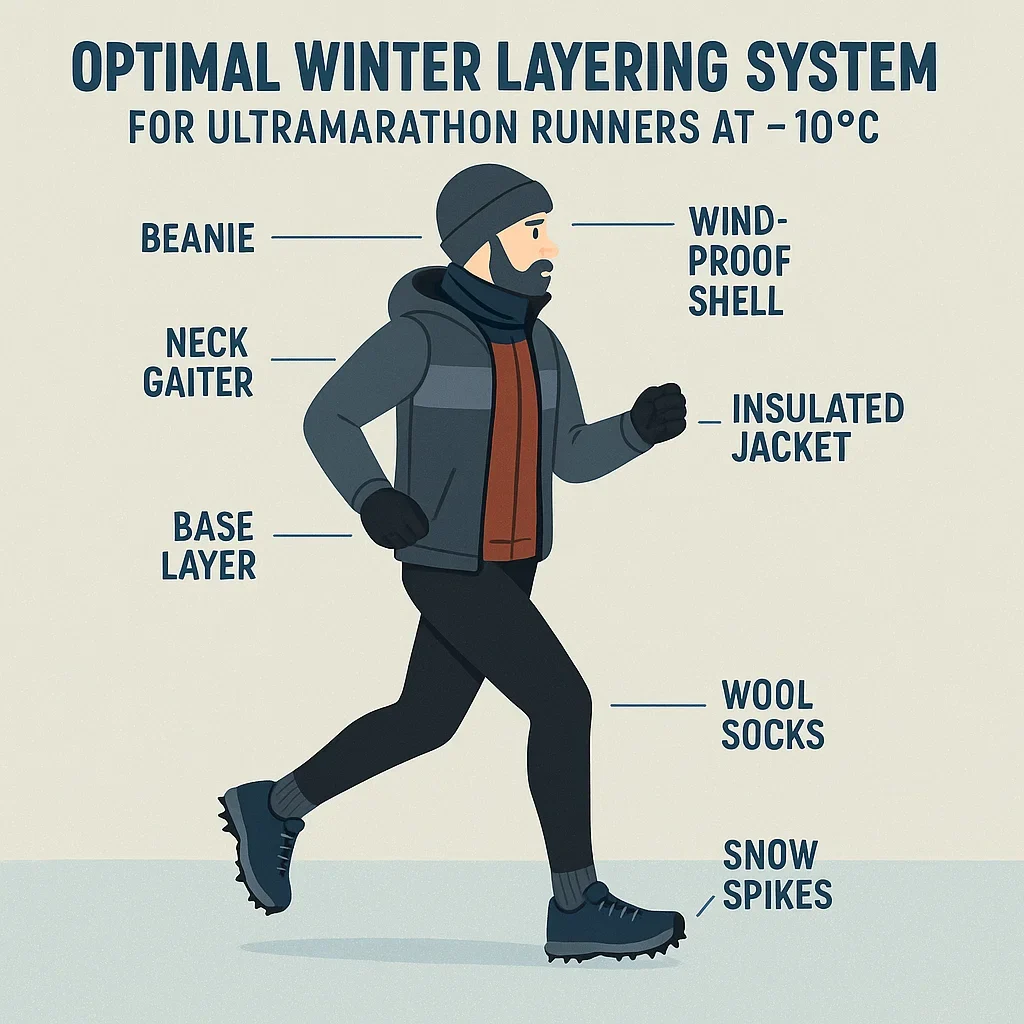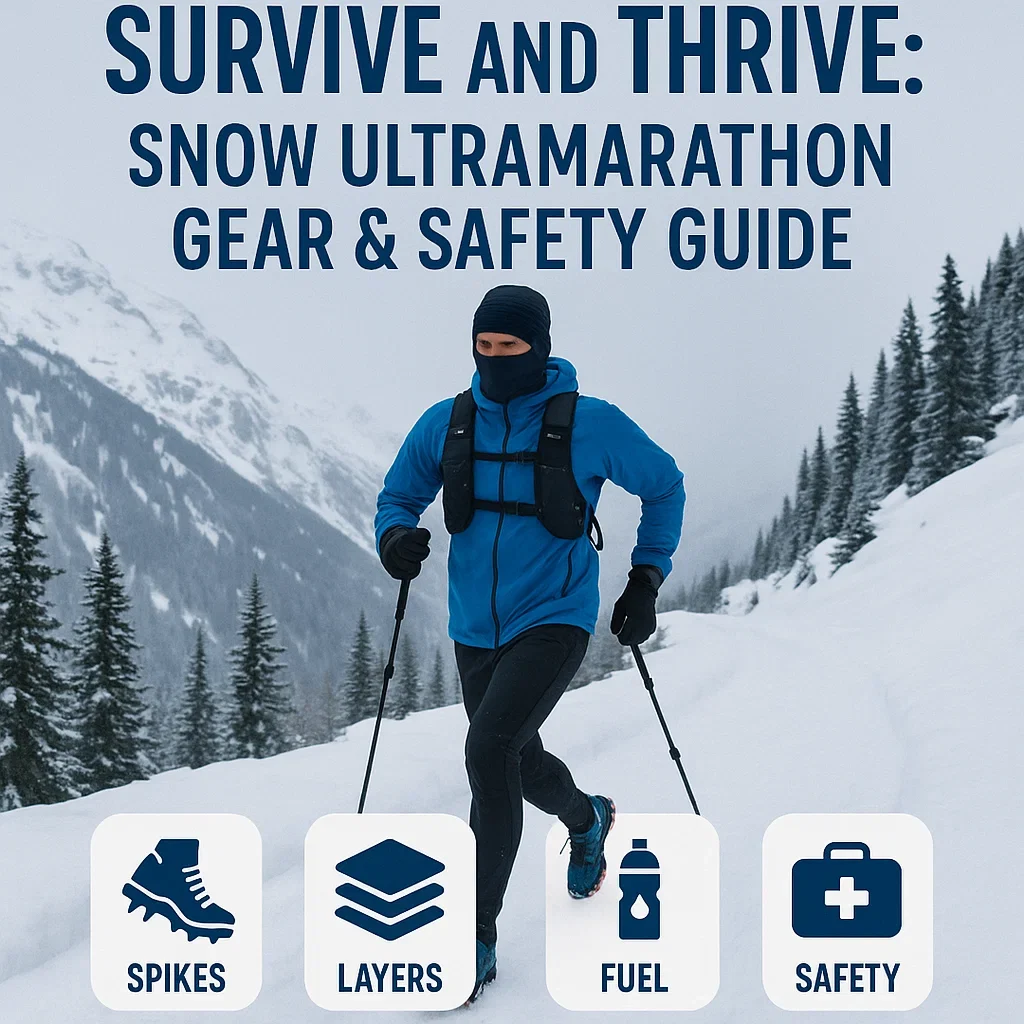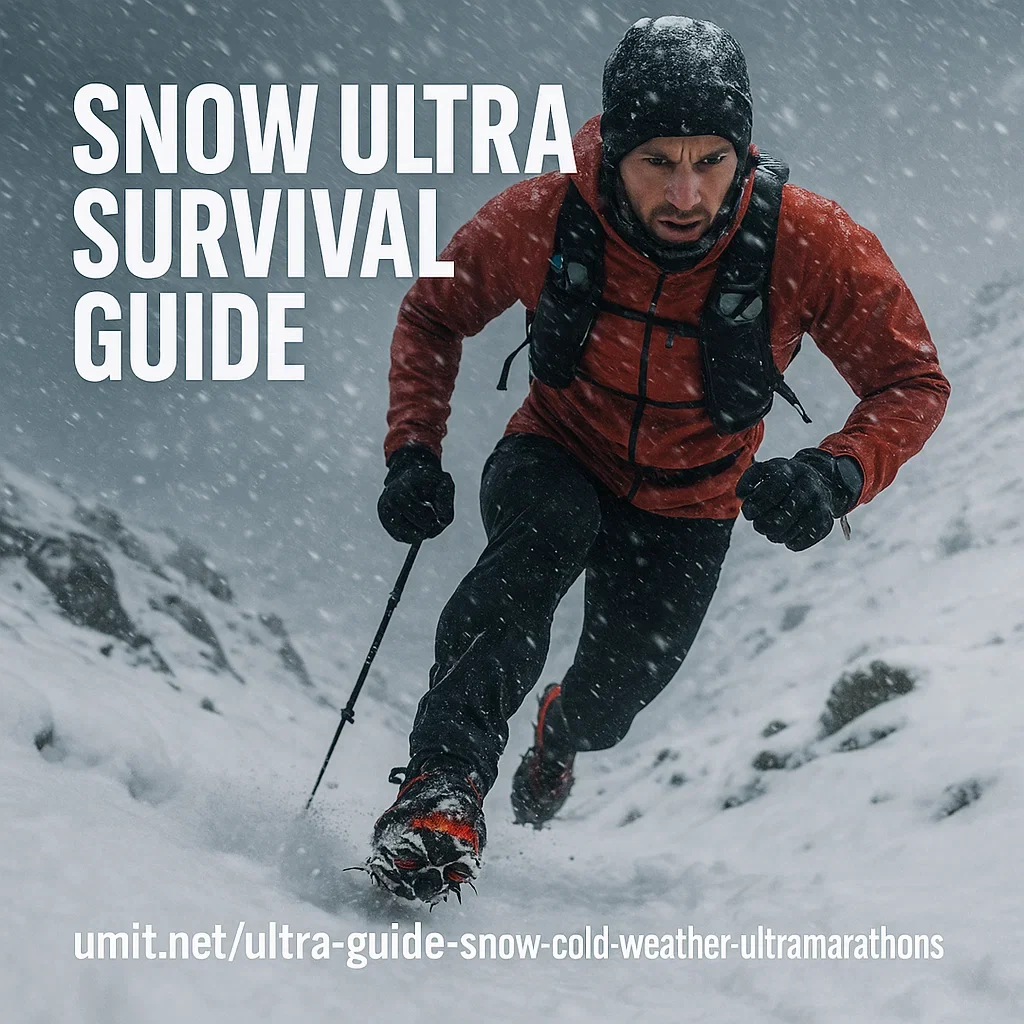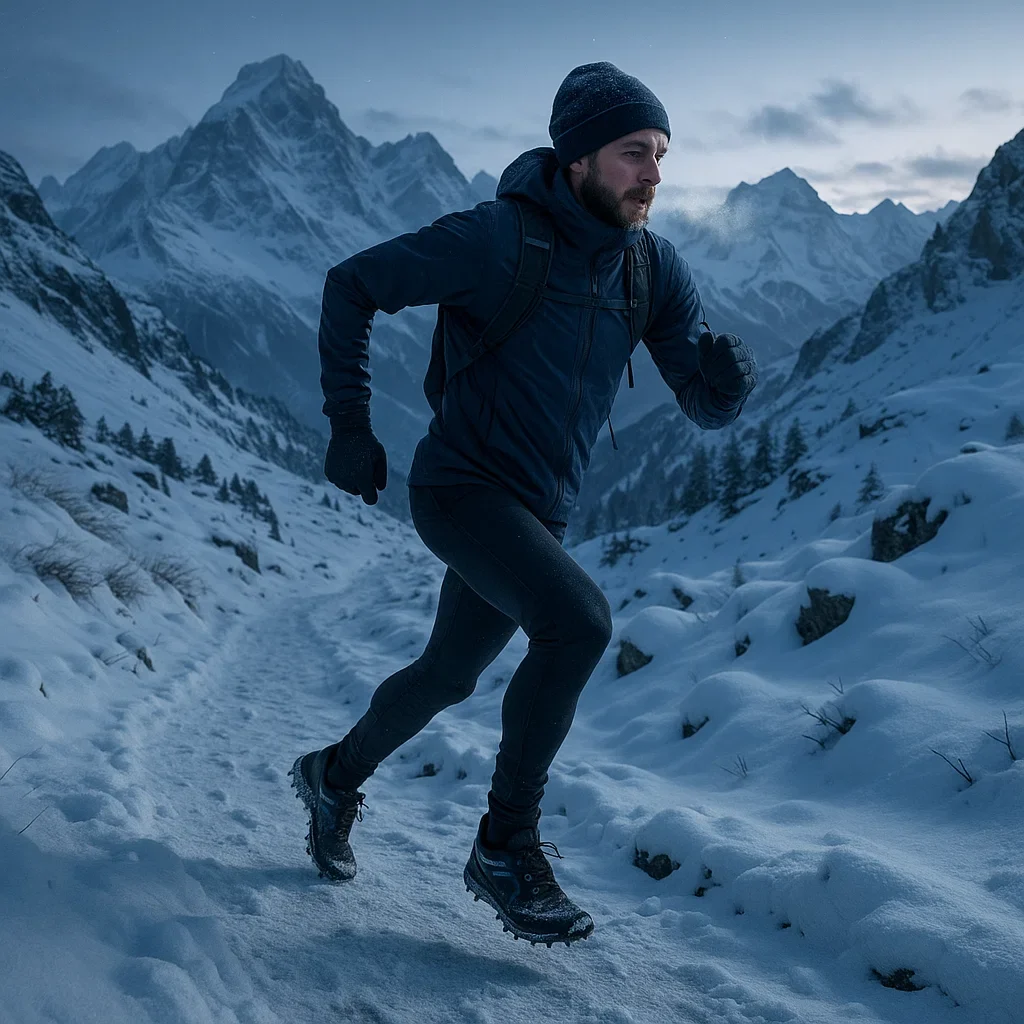❄️ Ultra Guide to Snow and Cold-Weather Ultramarathons 🏔️
Running an ultramarathon is tough. Running it in snow, ice, and freezing winds? That’s a whole new level! Whether you’re dreaming of the Yukon Arctic Ultra or signing up for your local winter ultra, you need more than willpower. This guide unlocks the secrets of gear, fueling, layering, and safety in subzero ultras – with tips from elite runners, lost pace wisdom, and interactive blocks to test your know-how.
- ✔️ Best spikes for snow & ice (with real runner reviews)
- ✔️ Layering secrets for –10°C and colder
- ✔️ Fueling & hydration that works (no frozen gels!)
- ✔️ Hypothermia signs you can’t ignore
- ✔️ Mini quizzes & tips from experienced ultra athletes
Cold ultras are less about speed, more about survival and smart decisions. Never underestimate how quickly the weather can turn, or how much energy it takes to stay warm!
“The cold will find your weakness. Gear and mindset matter as much as fitness. My best advice? Never gamble with the weather.”
– Scott Jenkins, Arrowhead 135 Finisher
🥾 Snow Ultra Spikes: Best Options & Runner Insights
Ever slipped on an icy singletrack at kilometer 40? Snow and ice can turn any ultramarathon into a survival game. That’s why choosing the right spikes matters as much as your fitness. Here’s how to stay upright and fast when the trail is frozen solid:
- EXOspikes
- MICROspikes
- Hillsound
- Yaktrax
- Other
❓ Quick Q&A: “Can you finish a snow ultra without spikes?”
🧤 Layering System for –10°C: Warmth Without Sweat
Staying warm at –10°C is science, staying dry is an art.
Layering for winter ultras isn’t just about piling on clothes. Overdress and you sweat; underdress and you risk hypothermia. The golden rule: Dress so you feel slightly cold at the start – you’ll warm up fast!
- Base Layer: Synthetic or merino long-sleeve (no cotton!)
- Midlayer: Lightweight fleece, grid hoodie, or thin insulated jacket
- Shell: Windproof and/or waterproof, breathable (Gore-Tex, Pertex, etc.)
- Legs: Thermal tights or double layers (e.g. thin wool tights + wind pants)
- Hands: Liner gloves + insulated mitts (swap as needed)
- Head/Neck: Beanie or buff + windproof headband + neck gaiter
- Feet: Wool or synthetic socks (double up if needed, consider gaiters)
“Think in layers: start cool, add insulation only when you slow down or stop. Don’t wait until you’re shivering!”
– Sarah Keyes, Winter Ultra Specialist
- Overdressing and sweating
- Starting too cold
- Forgetting wind protection
- Neglecting hands or head
❓ Q&A: “How do I know if I’ve layered correctly for a winter ultra?”
🍫 Cold Weather Fueling: What Works When Everything Freezes?
Fueling a cold ultra is a whole new game. At –10°C, your gels turn into rocks, your water bottle freezes, and your appetite vanishes. But your body’s still burning calories to keep you warm—and you risk bonking or hypothermia if you get it wrong. Here’s how to keep your energy high and your fuel liquid!
“Switch to more liquid calories (hot broth, soft chews, nut butter packets) and insulated bottles. Stash everything close to your body heat. Set a timer to remind yourself—your sense of thirst and hunger is suppressed in the cold!”
– Dr. Emily Collins, Sports Nutritionist
- Hydration: Use insulated bottles (or keep them inside your vest/jacket), refill with warm liquids at every aid station.
- Calorie Intake: Aim for 200–300 kcal/hour (just like summer!). Use gels/chews that don’t harden, or opt for nut butters and honey packs.
- Storage: Keep snacks in inner pockets or next to your skin (waist, chest, arm sleeves) to prevent freezing.
- Hot Fuel: Sip warm tea, broth, or soup when available for calories and comfort.
- Timing: Set alarms or reminders to eat/drink every 30 minutes—your appetite will hide!
- Practice: Test your nutrition in cold training runs. If it freezes at home, it’ll freeze faster on the course!
- Frozen water bottles
- Hard gels/bars
- Lost appetite
- Numb fingers (can’t open anything!)
❓ Q&A: “How can I avoid bonking in a snow ultra?”

🥶 Hypothermia Signs in Ultra Running: What Every Snow Racer Must Know
Cold kills… slowly, then suddenly. In snowy ultras, hypothermia can creep up even if you feel “just tired.” Recognizing danger signs is your best defense. Here’s how to spot trouble—before it’s too late:
“Watch for ‘the umbles’—mumbles, stumbles, fumbles, grumbles. Mental changes are as dangerous as shivering or cold skin. If in doubt, add layers, move to shelter, and get warm fuel fast.”
– Dr. Jason Lim, Race Medic, Arrowhead 135
- Shivering (can be violent, then stops as hypothermia worsens!)
- Clumsy or slow movement
- Confusion, irritability, “spacing out”
- Slurred speech or mumbling
- Fumbling gear or dropping things
- Sudden exhaustion or unwillingness to move
- Blue lips, pale skin
- Yes, it was scary
- Not sure, maybe?
- No, but I always watch for it!
❓ Q&A: “What’s the fastest way to treat mild hypothermia mid-race?”
🧑🚒 Mitigating Cold-Related Risks: Before, During & After the Race
Preparation is survival. In winter ultras, every step from the day before the start to your first meal after the finish matters. Here’s how to stack the odds in your favor—no matter how wild the weather gets.
- Before the Race:
- Train in cold conditions—test all gear, nutrition, and hydration in real weather.
- Start fully fueled and hydrated (don’t skip your pre-race meal or water!).
- Bring backup: extra gloves, socks, and a warm “emergency” layer (down/synthetic jacket or even a trash bag).
- During the Race:
- Adjust layers often—vent when you’re hot, bundle up before you get cold.
- Fuel and hydrate on a strict schedule, not by “feeling.”
- Use wind breaks, sun, and aid stations to stay warm and dry.
- Monitor yourself and your friends for hypothermia signs—ask “Are you okay?” often.
- Slow down before you crash; it’s better to finish than to drop with frostbite!
- After the Race:
- Change out of wet clothes immediately.
- Get into a warm shelter, wrap up, and start eating and drinking (preferably something hot).
- Check hands, feet, and nose/ears for frostbite—warm slowly, not with direct heat.
- If you feel weak, confused, or shiver uncontrollably, tell race medics right away!
- Extra gloves
- Trash bag or space blanket
- Extra fuel/food
- Emergency card
❓ Q&A: “Is it ever OK to skip the mandatory gear?”
🥾 2023+ Snow Ultra Spikes Comparison Table
Choosing the right spike for a snow ultramarathon can make or break your race. Below is a side-by-side comparison of the most popular models (2023 and newer), with weight, durability, price, and standout features. Tip: Prioritize durability and fit—not just price!

❓ Frequently Asked Questions
🧊 What makes a snow ultra so different from a summer ultra?
Extreme cold, ice, and snow change everything: gear, fueling, pacing, safety, and even your mental game. Mistakes are punished quickly!🥾 Do I need special shoes or can I just use spikes?
Most runners use their favorite trail shoes, adding spikes for grip. In deep snow, waterproof trail shoes or a shoe cover/gaiter combo help keep feet dry.⚡ What’s the #1 beginner mistake in winter ultras?
Overdressing! Start a bit cold—if you sweat too much, you’ll chill fast later. Test your layers in training.🩲 Cotton base layer—good or bad?
Bad! Cotton traps moisture and chills you when wet. Always use synthetic or merino wool.🥶 How do I tell if I’m getting hypothermic?
Early signs: shivering, clumsiness, confusion, fumbling gear, and slurred speech. If you or a friend show these, act quickly—add layers, move, eat!💦 Should I drink less since I sweat less in the cold?
No! You still need fluids—just monitor for frozen bottles. Use insulated flasks and drink on a schedule.🍫 My gels and bars freeze. What do I do?
Keep nutrition close to your body (inner pocket/vest) and test your fuel in cold training runs. Switch to chews, nut butters, or hot fluids if needed.🧤 How many pairs of gloves do I really need?
At least two: a lighter pair for moving, and a thicker/backup pair for rest stops or emergencies. Mittens are warmer than gloves!🧣 Buff, beanie, or both?
Both! A buff covers neck and lower face, a beanie keeps head heat in. Windproof ear covers add extra warmth.👣 Should I double up my socks?
For very cold races, yes: try a thin liner plus a warm wool outer sock. Make sure your shoes aren’t too tight!🦶 How do I prevent blisters in wet snow?
Use moisture-wicking socks, gaiters, and re-lube feet at aid stations. Change socks if they get wet!🛑 What’s the emergency “must-carry” for snow ultras?
Emergency blanket or trash bag, extra gloves, hat, calories, and a charged phone. Don’t skip mandatory kit!🏁 How should I pace a snow ultra?
Start slower than usual—the cold and tricky footing make everything more draining. Save energy for the final hours!🦺 What’s the safest way to warm up if I get chilled?
Get out of the wind, put on dry layers, move gently, and eat/drink something warm. Avoid direct heat on numb skin.🧑🤝🧑 Should I run with a buddy?
Yes, if possible! It’s safer—friends spot hypothermia and help motivate each other when it gets tough.📱 How do I protect my phone/electronics from freezing?
Keep electronics close to your body, insulated in a dry bag or sock. Batteries drain fast in the cold!🍲 Is hot food really that important?
Yes! Hot broth or soup warms you up and makes calories easier to digest. Carry a small insulated flask if you can.🧪 Any special tips for female runners?
Women may get cold faster, especially hands and feet. Prioritize extra hand warmers, layer options, and practice bathroom breaks with gloves on!🚿 How do I recover after a cold ultra?
Change out of wet gear, get warm food and drink, and warm up gradually (not with a super-hot shower). Monitor for delayed hypothermia signs.🌎 What if the race is cancelled or rerouted for weather?
Respect the call—organizers know the risks. There’s always another race, but only one you!📚 Further Reading & Resources
- iRunFar – Winter Ultramarathon Gear Guide — Real-world reviews and cold race tips
- Outside – Cold-Weather Fueling for Ultra Runners — Science-backed fueling strategies for subzero ultras
- Runner’s World – Winter Running Survival Guide — Layering, safety, and mental tactics
- NCBI – Hypothermia in Endurance Events — Medical research & prevention

📝 Snow & Cold-Weather Ultra Quiz
- What’s the most important factor in choosing snow spikes for a 50K ultra?
- Why is cotton dangerous for a base layer in cold races?
- Name two symptoms of early hypothermia during a winter ultra.
- What’s the ideal starting “feeling” at the start line—warm, cold, or hot?
- Best location to store your energy gel in –10°C?
- Which is more important: fueling by schedule, or only when hungry/thirsty?
- What’s the safest way to treat mild hypothermia mid-race?
- Name one “must-carry” emergency item for a snow ultra.
- Why is it risky to overdress at the start?
- What’s a key sign your hydration strategy is failing in freezing temps?
- How many pairs of gloves should you bring for a 100K snow race?
- What’s the danger of tight shoes with double socks?
- When should you change out of wet clothes—immediately or after you warm up?
- Best material for ultra socks in deep snow: wool, cotton, or silk?
- Name one way to keep water from freezing during the race.
- What is “the umbles” in hypothermia (list two)?
- Which item drains battery fastest in subzero weather: phone, GPS watch, or camera?
- Why are hand/foot warmers a smart addition to your kit?
- When is it OK to skip mandatory gear?
- What should you do first after finishing a snow ultra?
✅ Quiz Answers
- Durability and tooth design (carbide/steel teeth, fit)
- Cotton absorbs sweat, chills you, never dries—risk of hypothermia
- Shivering, confusion, clumsiness, slurred speech
- Slightly cold—you’ll warm up fast once moving
- Inside a pocket or against your body, to prevent freezing
- By schedule (thirst/hunger is suppressed in cold)
- Add dry layers, shelter, eat/drink something warm
- Emergency blanket, extra gloves, food, phone, etc.
- You’ll sweat, then get chilled and risk hypothermia later
- Frozen bottles, lack of urination, dizziness, dry mouth
- At least two (light & heavy); more if prone to cold hands
- Restricted circulation—risk of frostbite and blisters
- Immediately—don’t wait to get warm
- Wool—best warmth when wet, dries fast
- Insulated bottles, body heat, keep close to your core
- Mumbles, stumbles, fumbles, grumbles, tumbles
- Phone (most exposed, batteries hate cold!)
- Help prevent frostbite and keep extremities warm
- Never—mandatory kit saves lives
- Change clothes, get warm, eat/drink, monitor for issues
Share your score and challenge a friend! 🚀
🏁 Final Thoughts: Embrace the Cold, Own the Ultra
Winter ultramarathons aren’t just about speed—they’re about grit, planning, and respect for the elements. Whether you’re eyeing your first snow ultra or aiming for a PR, the right spikes, smart layering, disciplined fueling, and risk awareness will make you unstoppable.
Share your experience or ask a question below—let’s build a smarter, safer ultra community!
43 Minutes Straight of SOLID Recovery Advice For Runners Over 50
Comprehensive recovery strategies tailored for runners over 50, emphasizing the importance of rest and recovery in performance and longevity.
Why Your Running Slows Down After 50 (And How to Fix It)
Insights into the four stages of the older endurance runner’s journey and practical tips to prevent unnecessary declines in performance.
Running over 40, 50, and Beyond; Tips for Middle Age Runners
Practical advice for middle-aged runners, focusing on training adjustments and recovery techniques to maintain performance.
Top 5 Tips for Runners Aged 40+ – How to Recover Quicker
Five essential recovery tips specifically designed for runners aged 40 and above to enhance recovery speed and efficiency.
Master Your Running Recovery: The Ultimate 7-Step Guide
A comprehensive seven-step guide to mastering running recovery, suitable for runners seeking to optimize their post-run routines.
Tim Tollefson’s Best Recovery Tips After an Ultramarathon Race
Professional ultrarunner Tim Tollefson shares his top recovery strategies following grueling ultramarathon races.

About the Author
Lost Pace is an ultramarathon runner, shoe-tester and the founder of umit.net. Based year-round in Türkiye’s rugged Kaçkar Mountains, he has logged 10,000 + km of technical trail running and completed multiple 50 K–100 K ultras.
Blending mountain grit with data, Lost analyses power (CP 300 W), HRV and nutrition to craft evidence-backed training plans. He has co-written 260 + long-form guides on footwear science, recovery and endurance nutrition, and is a regular beta-tester of AI-driven coaching tools.
When he isn’t chasing PRs or testing midsoles, you’ll find him sharing peer-reviewed research in plain English to help runners train smarter, stay healthier and finish stronger.
Ultrarunner · Data geek · Vegan athlete

